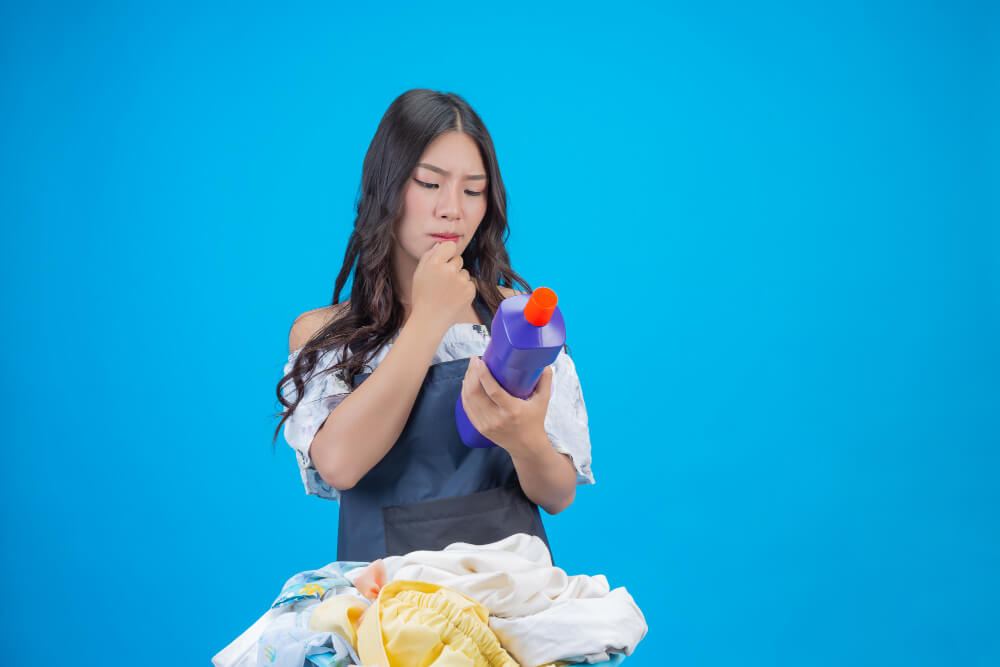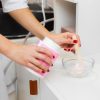- Empty cart.
- Continue Shopping
Say Goodbye to Tough Stains: Pro Tips for Flawless Laundry

Everyday life brings numerous stains which people encounter all the time. When stains appear on clothing they can be difficult to remove because they affect both white shirts stained with red wine and children’s uniforms marked by mud and greasy food accidents at lunchtime. Proper stain removal methods coupled with suitable techniques enables you to get rid of difficult marks thus maintaining your clothes’ natural condition.
In this blog, we will delve deep into the world of laundry care and provide you with professional tips to tackle tough stains effectively. From understanding different types of stains to knowing how to choose and use the best stain remover liquid, this comprehensive guide is your one-stop solution for spotless laundry.
Understanding the Nature of Stains
The first move requires knowing the root of the issue before selecting remedies. The successful cleaning of stains depends on what specific type of stain you are dealing with. Everything starts with selecting an appropriate product and technique for stain removal because detergent strength alone cannot achieve perfect laundry results.
Protein-based Stains: The most common stains that need attention are blood materials, sweat samples, dairy substances and egg deposits. Stains from proteins require only cold water treatment before any other solution. Water at a high temperature has the ability to heat protein-based stains so they become less manageable by laundry cleaners. You should select enzyme-based stain removers over other options for treating these stain categories.
Oil-Based Stains: The classification includes grease, butter, salad dressings alongside motor oil. When stains fasten to fabric material they need a degreasing agent for treatment. Heating the water above cold temperature is typically necessary to soften oil before cleaning. High-grade grease-fighting stain removers as liquids will work effectively when used on such stains.
Tannin Stains: The stain group encompassed by this classification consists of tea, coffee, wine alongside fruit juices. Vinegar and plant-based stains represent difficult stains because applying soap to them at first will make the stain permanent. The first step should be cold water rinsing before applying a specialized stain remover.
Dye Stains: Colored fluids together with natural dyes form the group of dye-based stains. This kind of stain infiltrates fabrics fast so it becomes tough to eliminate. The combination of solvents with color-lifting agents in a strong stain removing liquid brings exceptional results.
Combination Stains: These are the most complex, as they involve multiple components. For instance, a slice of pepperoni pizza might leave a stain that contains oil, protein, and dye. Treating each part of the stain step-by-step using targeted stain removers is key.
Choosing the Right Stain Remover Liquid
Laundry detergent by itself isn’t always sufficient to maintain clean fresh spots free laundry particularly in situations where stains resist like grease wine ink and grass. Stain remover liquid proves essential for this purpose. The ultimate stain remover liquid requires both strong stain-breaking efficiency alongside mild treatment of fabric material during stain removal operations.
Stain removers belong to different classes of effectiveness. An effective stain remover product combines enzymes that dissolve proteins oils and starches with surfactants which actively remove stains from fibers. Select a single liquid stain remover which effectively removes stains from all your garments starting with a little one’s clothing mess to food-spilled aprons and office-dirty ink stains.
An ideal stain remover needs to deliver effective removal for every major kind of staining material including food accidents, oily residues, cosmetic stains, dirt and ink blots. The chemicals found in cheap stain removers often damage fabric dyes while producing undesirable light areas on fabrics.
- Multi-Purpose Effectiveness
A great stain removal solution enables us to use it on all types of fabric material. Search for a stain remover which shows excellent performance on basic fabrics combined with sensitive materials like silks, linens and wool blends. The stain remover must have protective components which prevent fabric deterioration or split ends while you treat and wash stains.
- Safe for All Fabrics
The successful removal of stains requires a stain remover which provides color protection. Low-quality stain remover products contain rough chemicals which might damage fabric dyes while simultaneously forming undesirable pale blotches on fabrics. Select “color-safe” stain remover liquids because they safeguard against dye loss and color changes particularly vital for brightly colored and patterned garments or dark materials.
- Color-Safe and Non-Bleaching
The preservation of color represents an essential aspect. Low-quality stain removal products contain strong chemicals which remove color while producing unappealing white discolorations. Use a stain remover with “color-safe” markings to protect your clothing from discoloration or fading damage especially when cleaning bright or dark or patterned garments.
- Eco-Friendly and Non-Toxic Ingredients
People in our environmentally-aware society should make responsible choices by purchasing sustainable cleaning products. Modern stain remover liquids use plant-based ingredients which do not contain phosphates or chlorine or artificial dyes. Biodegradable solutions offer safety to people in your household together with environmental protection.
- User-Friendly Packaging
The ease at which users can apply a product stands as an important yet frequently disregarded quality. Begin stain treatment by using a clean cloth to carefully blot the affected area which will help remove the stain.
- Dermatologically Tested for Sensitive Skin
You should select a dermatologically tested stain remover when you or anyone in your family experiences sensitive skin. The stain remover works better after 5 to 15 minutes (or longer for challenging stains) has passed.
Application Techniques That Work
Once you’ve chosen your stain remover liquid, the way you apply it is equally important. Here’s how to maximize its effectiveness:
- Blot, Don’t Rub: Start by blotting a fresh stain with a clean cloth to capture as much liquid as you can until a stain remover or washing step follows. Stain spreading occurs when friction forces a stain to penetrate and reach deeper levels within the fabric.
- Apply Generously: Ensure you invest enough stain remover for optimal effectiveness. Use a large enough stain removal product dab onto the mark and blend it by using your fingers or a soft-bristled brush.
- Let It Sit: Stain remover needs contact time to work efficiently on fabric tissue. Allowing the stain remover to rest for 5–15 minutes (or longer for stubborn stains) leads to better results.
- Wash Appropriately: Wash every piece of clothing in water temperatures that the fabric can handle. Keep your clothes safe from damage by following all instructions specified on the label.
- Repeat If Necessary: Some stains may require more than one treatment. Don’t dry or iron the garment until the stain is completely gone, as heat can set the stain permanently.
Tackling Common Stain Scenarios
Let’s take a look at some common stain scenarios and the professional methods to address them.
Red Wine on Cotton Shirt: Use a paper towel to dry the wine stain quickly while it remains damp. Disperse salt or baking soda across the stain to wick away additional moisture. Start by rinsing the stain with cold water then apply the stain remover liquid before washing as you normally would. Apply the treatment once again if you still detect any residue that remains before letting the fabric dry.
Grease from Fast Food: Use a dry napkin to remove as much oil from the surface as you can. Allow dish soap or stain remover liquid to stay on the spot for 10–15 minutes before washing. After washing with hot water examine the stain before allowing clothes to dry.
Grass Stains on Jeans: Soak the jeans in cold water. Gently brush a big amount of stain remover liquid onto the affected area. Wash with a heavy-duty detergent. Repeat as needed.
Ink from a Leaky Pen: Apply a cotton ball that contains rubbing alcohol for spot treatment. Treat the stain with liquid stain remover before rinsing with cold water. Launder as usual.
DIY Alternatives and When to Use Them
There are moments when you might not have a stain remover liquid on hand. In such cases, common household items can be temporary substitutes:
- Baking Soda: Mixed with water, it can lift minor stains and absorb odors.
- White Vinegar: Good for tannin-based stains and as a fabric softener.
- Lemon Juice: Works well for sweat stains and freshening whites.
- Hydrogen Peroxide: A gentle bleaching agent effective on organic stains. Always test on an inconspicuous area first.
The substitutes succeed temporarily but they do not compare to professional stain remover solutions. The effectiveness of these methods depends on the fabric type and the intensity of the stain.
Preventing Stains Before They Happen
Prevention is better than cure, and this holds true for laundry care as well. Here are some proactive habits that can minimize staining:
- Always wear an apron while cooking.
- Keep pens capped and away from shirt pockets.
- Avoid eating messy foods in your favorite clothes.
- Store stain remover pens or sprays in your car, office, or handbag.
- Treat potential stains immediately instead of waiting for laundry day.
Caring for Delicate and Specialty Fabrics
Not all fabrics can withstand the same treatments. Here’s how to handle different types:
- Silk and Wool: Use only gentle, enzyme-free stain removers. Cold water is crucial.
- Denim and Heavy Cotton: Can handle stronger solutions and scrubbing. Turn inside out for washing.
- Synthetic Sportswear: Use low-temperature water and gentle formulas to preserve elasticity.
Environmentally Friendly Stain Removal
An increasing number of people seek cleaning solutions for laundry that prioritize sustainability. The purchase of concentrated products for stain removal helps decrease plastic waste and drying clothing by air instead of using electricity reduces energy usage. Use concentrated cleaning products to minimize plastic waste and dry your clothes outside to lower your household electricity use.
Organizing a Laundry Stain Kit
To ensure you’re always ready for a laundry emergency, consider creating a laundry stain kit. Include:
- Stain remover liquid
- Old toothbrush or soft brush
- White vinegar
- Baking soda
- Clean cloths
- Gloves
Having a well-stocked kit at hand ensures you can act quickly and effectively, improving your success rate in removing stains.
Final Thoughts
Everyone should watch out for stains because they inevitably appear despite our best preventive efforts. Your clothes’ freshness depends on understanding stain science rather than using professional laundry services. Having pristine clothes requires knowledge about stain science and dependable cleaning products instead of relying on professional laundry services for upkeep. You can now enjoy perfect laundry results without stress because perfect laundry results are now within your reach through this solution.







